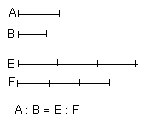If four magnitudes be proportional, they will also be proportional alternately.
 Let A, B, C, D be four proportional magnitudes, so that, as A is to B, so is C
to D.
Let A, B, C, D be four proportional magnitudes, so that, as A is to B, so is C
to D.
 I say that they will also be so alternately, that is, as A is to C, so is B to
D.
I say that they will also be so alternately, that is, as A is to C, so is B to
D.
 For of A, B let equimultiples E, F be taken,
For of A, B let equimultiples E, F be taken,
 and of C, D other, chance, equimultiples G, H.
and of C, D other, chance, equimultiples G, H.
 Then, since E is the same multiple of A that F is of B, and parts have the
same ratio as the same multiples of them, therefore, as A is to B, so is E to
F.
Then, since E is the same multiple of A that F is of B, and parts have the
same ratio as the same multiples of them, therefore, as A is to B, so is E to
F.
 But as A is to B, so is C to D; therefore also, as C is to D, so is E to F.
But as A is to B, so is C to D; therefore also, as C is to D, so is E to F.
 Again, since G, H are equimultiples of C, D, therefore, as C is to D, so is G
to H.
Again, since G, H are equimultiples of C, D, therefore, as C is to D, so is G
to H.
But, as C is to D, so is E to F; therefore also, as E is to F, so is G to H.
 But, if four magnitudes be proportional, and the first be greater than the
third, the second will also be greater than the fourth; if equal, equal; if
less, less.
But, if four magnitudes be proportional, and the first be greater than the
third, the second will also be greater than the fourth; if equal, equal; if
less, less.
Therefore, if E is in excess of G, F is also in excess of H, if equal, equal,
if less, less.
 Now E, F are equimultiples of A, B, and G, H other, chance, equimultiples of
C, D;
Now E, F are equimultiples of A, B, and G, H other, chance, equimultiples of
C, D;
 therefore, as A is to C, so is B to D.
therefore, as A is to C, so is B to D.
Therefore etc.
Q.E.D